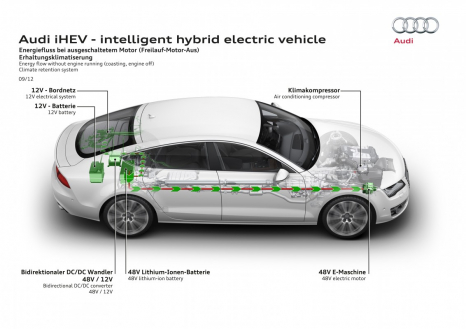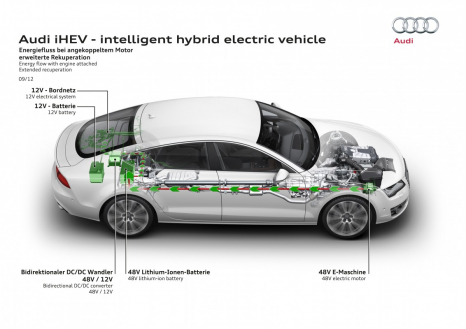Predictive efficiency assistant
Audi is working on new, intelligent technologies to reduce fuel consumption even further. The predictive efficiency assistant uses data from the navigation system to enable the car to slow down in an anticipatory manner.
The open road can be full of surprises – signs indicating speed limits or residential areas can appear suddenly over the crest of a hill, forcing the driver to brake. In conventional vehicles, however, braking means that kinetic energy is converted into heat. It would be far more efficient if the driver could start to decelerate earlier and coast down to the speed limit in a more controlled manner – which would mean knowing what lies ahead.
Precisely this capability is the focus of the predictive efficiency assistant (PEA), one of Audi’s advanced development projects. Its objective is to use the route information from the navigation system for drive management. The new major expansion level of the MMI Navigation plus incorporates not only speed limits but also gradient data. This enables the drive management system to determine how the stretch should be driven. It is supported by the adaptive cruise control, which monitors the traffic ahead. The PEA also takes into account the current vehicle mass and possible add-on extras like roof boxes or similar items.
The predictive efficiency assistant advises the driver when he can commence a comfortable coasting sequence that will not hinder other road users behind him. The indication can appear in the driver information system display or via a haptic signal like a pulse sent through the gas pedal. Alternatively, the driver can also simply use the coasting capabilities of the adaptive cruise control.
Depending on vehicle and equipment, coasting can occur with the driveline coupled, i.e. conventional trailing throttle, or decoupled, i.e. freewheeling. Some A3* and Q3* variants come equipped with a freewheeling function; depending on the engine and gearbox configuration, it saves more fuel than trailing throttle. The hybrid models in the A6*, A8 and Q5* ranges often coast entirely without engine drag torque. If the driver takes his foot off the gas – even at higher speeds – the TFSI is decoupled and deactivated; only the electric motor provides slight braking in order to charge the lithium-ion battery.
In future, a comparable function could also be possible in conventional drives. Audi is working on a technology bearing the acronym iHEV. On lifting off the gas, the engine is deactivated and later reactivated smoothly and comfortably by a belt-driven starter-generator. Components like power steering, air conditioning and the brake servo unit are electrified, drawing their energy from a powerful 48-volt vehicle electrical system.
In cooperation with the predictive efficiency assistant, iHEV vehicles can take full advantage of their entire fuel consumption potential, as comparative drives with a technology mule have indicated. The A7 Sportback 3.0 TFSI iHEV completed several drives along a 61 km stretch of winding, out-of-town road in normal everyday driving conditions. On the tests without data support, the driver covered 28 percent of the route with the engine deactivated. With data support active, this proportion rose to 43 percent, while fuel consumption dropped by around 10 percent. Driving time was lengthened by just two minutes.
In future, the networking functions of Audi connect can ensure that the predictive efficiency assistant uses up-to-the-minute data. If an Audi identifies a speed limit with its video camera, at a newly established construction site for example, it sends it via the cell phone network to a server in the Audi computer center. There, the information is validated and sent out to all suitably equipped vehicles driving the same route – a concrete usage example for forthcoming car-to-x technology.
Audi A3 Combined fuel consumption in l/100 km: 7 – 3.2; Combined CO2-emissions in g/km: 162 - 85**
Audi Q3 Combined fuel consumption in l/100 km: 8.8 – 5.2; Combined CO2-emissions in g/km: 206 - 137**
Audi A6 hybrid Combined fuel consumption in l/100 km: 6.2; Combined CO2-emissions in g/km: 145**
Audi A8 hybrid Combined fuel consumption in l/100 km: 6.2; Combined CO2-emissions in g/km: 144**
Audi Q5 hybrid Combined fuel consumption in l/100 km: 6.9; Combined CO2-emissions in g/km: 159**
**Figures depend on the tires/wheels used.
Status: 2012

